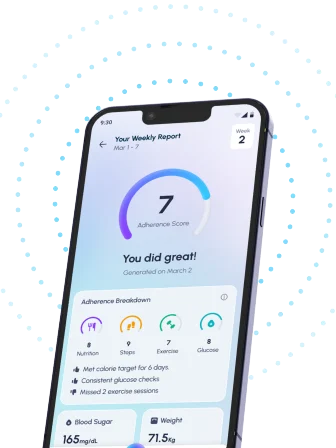Table of Contents
- Diabetes & Aging: How Exercise Impacts ATP Production
- The Role of Exercise in Maintaining ATP Levels with Age and Diabetes
- Boosting ATP: Exercise Strategies for Older Adults with Diabetes
- Understanding Age-Related ATP Changes in Individuals with Diabetes
- Exercise and ATP: A Guide for Seniors Managing Diabetes
- Frequently Asked Questions
- References
Aging gracefully is a goal for many, but the impact of time on our bodies, especially concerning conditions like diabetes, can be a significant concern. This blog post dives into the fascinating connection between diabetes, aging, and exercise, specifically exploring how our cellular energy production, measured by ATP levels, changes as we get older. We’ll unpack the science behind this vital process and discuss practical strategies to help you maintain energy and well-being. Understanding the relationship between Diabetes, Aging, and Exercise: How ATP Changes with Age is key to proactive health management. Let’s get started!
Diabetes & Aging: How Exercise Impacts ATP Production
The Crucial Role of ATP
Maintaining healthy ATP (adenosine triphosphate) production is vital, especially as we age. ATP is the body’s energy currency, powering all cellular functions. For individuals with diabetes, particularly those in the 65+ age group—representing 39% of the diabetic population according to the International Diabetes Federation—efficient ATP production is even more critical. Age-related decline in muscle mass and function, often exacerbated by diabetes, can significantly impact ATP synthesis.
Exercise: A Key to Boosting ATP
Regular exercise, tailored to individual needs and abilities, is a powerful tool to combat this decline. Appropriate physical activity stimulates the mitochondria, the powerhouses of our cells responsible for ATP production. This is crucial for individuals in Indian and tropical countries, where lifestyle factors often contribute to higher diabetes prevalence. Even moderate exercise, such as brisk walking or yoga, can significantly improve mitochondrial function and increase ATP production. For a deeper understanding of the vital role of exercise in diabetes management, read our article on Why Regular Exercise is Essential for Diabetes Management.
Age-Specific Considerations
For older adults with diabetes, it’s important to choose exercises that are safe and manageable. Low-impact activities like swimming or cycling are excellent choices, minimizing stress on joints. Consult with your doctor or a certified diabetes educator to develop a personalized exercise plan that takes into account your specific age, health condition, and climate. Remember to stay hydrated, especially in hot and humid tropical climates. If you’re experiencing persistent fatigue, you might find our article on Does Diabetes Make You Tired? helpful.
Taking Action
Prioritizing regular, appropriate exercise is a cornerstone of managing diabetes and promoting healthy aging. By improving ATP production, you can enhance energy levels, improve overall health, and increase your quality of life. Speak to your healthcare provider today to create a safe and effective exercise plan tailored to your needs.
The Role of Exercise in Maintaining ATP Levels with Age and Diabetes
Maintaining healthy ATP (adenosine triphosphate) levels is crucial, especially as we age and for individuals managing diabetes. ATP, the body’s energy currency, becomes increasingly challenging to produce efficiently with age, a process exacerbated by conditions like diabetes. The prevalence of diabetes is a significant concern globally, and in regions like India and other tropical countries, lifestyle factors often contribute to its development. This is particularly concerning given that approximately 35 per 10,000 U.S. youths have diagnosed diabetes, highlighting the need for preventative measures from a young age.
Exercise: A Key to ATP Production
Regular exercise plays a vital role in boosting ATP production and mitigating the effects of aging and diabetes. Physical activity improves cellular energy metabolism, enhancing the efficiency of mitochondria – the powerhouses of our cells responsible for ATP generation. For individuals with diabetes, maintaining sufficient ATP levels is crucial for effective glucose management and overall health. Activities like brisk walking, yoga, and strength training are particularly beneficial, improving cardiovascular health and insulin sensitivity. In hot and humid climates prevalent in many Indian and tropical countries, it’s essential to exercise smartly, staying hydrated and avoiding strenuous activity during peak heat hours.
Tailoring Exercise to Regional Needs
Considering the climate and lifestyle factors in India and other tropical regions, tailoring exercise routines is important. Choosing activities suitable for the heat and humidity, such as early morning or evening workouts, and incorporating culturally relevant forms of exercise, can increase adherence and long-term success. Consulting a healthcare professional is crucial, especially for those with diabetes, to create a safe and effective exercise plan that accounts for individual needs and health conditions. Remember, even modest increases in physical activity can significantly impact ATP production and overall well-being. Understanding the challenges of Managing Diabetes as You Age: Challenges and Solutions is also key to developing a sustainable approach to exercise and health management.
Actionable Steps for Better ATP Production
Start with short, manageable workouts and gradually increase intensity and duration. Incorporate a variety of exercises to target different muscle groups. Prioritize hydration, especially in hotter climates. Regularly monitor blood glucose levels (if applicable). And finally, seek advice from your doctor or a certified fitness professional to design a personalized plan. Taking these steps can significantly improve your energy levels and overall health. It’s also important to consider how stress hormones affect diabetes, as stress can impact blood sugar control and overall well-being.
Boosting ATP: Exercise Strategies for Older Adults with Diabetes
Understanding the ATP Challenge
Maintaining healthy ATP (adenosine triphosphate) levels is crucial for energy production, especially as we age. For older adults with diabetes, this becomes even more critical. High blood sugar, a hallmark of diabetes, can impair energy metabolism. The fact that HbA1c levels above 9% are reported in over 30% of diabetes patients highlights the prevalence of poorly managed blood sugar, further impacting ATP production. This can lead to fatigue, reduced physical function, and increased risk of complications. In hot and humid climates prevalent in many Indian and tropical countries, the challenge is amplified due to increased dehydration and heat stress.
Tailored Exercise for Optimal ATP
Fortunately, regular exercise plays a vital role in boosting ATP production and improving overall health in older adults with diabetes. However, the approach needs to be tailored. Low-impact activities like walking, swimming, or cycling are excellent choices, minimizing stress on joints. Yoga and Tai Chi are also beneficial, improving flexibility, balance, and overall well-being. Remember to consult your physician before starting any new exercise program, especially if you have pre-existing health conditions. Maintaining a healthy weight is also crucial, and for those needing to gain weight, How to Gain Weight with Diabetes Safely and Effectively – Tap Health offers helpful guidance.
Regional Considerations
In Indian and tropical countries, adjusting exercise routines to the climate is vital. Avoid strenuous activity during the hottest parts of the day. Stay hydrated by drinking plenty of water, especially before, during, and after exercise. Choosing shaded areas or indoor facilities can significantly reduce the risk of heatstroke and improve exercise tolerance. Remember, consistency is key; even short bursts of activity throughout the day can cumulatively improve ATP levels and overall health. Furthermore, strengthening your immune system is vital for managing diabetes effectively, and you can learn more about that in our article, Boosting Immunity While Managing Diabetes.
Taking Action
Start small, be consistent, and listen to your body. Regular exercise, tailored to your specific needs and the regional climate, is a powerful tool in managing diabetes, boosting energy levels, and improving your quality of life. Consult a healthcare professional or certified diabetes educator for personalized guidance.
Understanding Age-Related ATP Changes in Individuals with Diabetes
The Impact of Aging on Energy Production in Diabetics
The global burden of diabetes is staggering, with projections indicating a significant rise in prevalence in the coming decades. By 2045, 783.7 million people (aged 20-79) are expected to have diabetes, representing an increase from 9.8% in 2021 to 11.2% of the population. This increase is particularly relevant in Indian and tropical countries, where diabetes prevalence is already high and continues to grow. Understanding how aging affects energy production, specifically Adenosine Triphosphate (ATP), is crucial for managing diabetes effectively in these regions.
ATP Production and its Decline with Age
ATP, the body’s primary energy source, is produced through cellular respiration. In individuals with diabetes, this process can be impaired due to factors such as insulin resistance and vascular complications. Aging further exacerbates this issue, as mitochondrial function—the powerhouse of the cell responsible for ATP generation—naturally declines with age. This decline is often more pronounced in individuals with diabetes, leading to reduced energy levels, increased fatigue, and a greater susceptibility to complications. This is especially relevant in hot and humid climates prevalent in many Indian and tropical countries, where maintaining energy levels is crucial for daily life. Understanding the impact of diabetes on other bodily functions is also important, and you might find our article on Does Diabetes Affect Platelet Count? informative.
Practical Strategies for Maintaining Energy Levels
Maintaining healthy ATP levels is paramount for managing diabetes, especially as we age. Prioritizing regular, age-appropriate exercise is vital. Consult your physician or a certified diabetes educator to develop a personalized exercise plan that considers your age, health condition, and the climatic conditions of your region. This might include activities like brisk walking, yoga, or swimming, tailored to your individual needs and abilities. Furthermore, focusing on a balanced diet rich in nutrients vital for cellular health is crucial. Regular health check-ups are also essential for early detection and management of any complications. It’s also important to consider the specific challenges faced by younger individuals, as highlighted in our blog on Diabetes in Teenagers: Understanding the Impact – Tap Health.
Conclusion: Taking Control of Your Health
In Indian and tropical countries, proactive management of diabetes, particularly considering the interplay of aging and ATP production, is critical for improving quality of life. By following the advice of your healthcare provider and adopting a lifestyle focused on regular exercise and healthy eating, you can effectively manage your diabetes and maintain your energy levels, even as you age. Don’t hesitate to seek advice from a healthcare professional to devise a tailored plan that best suits your needs and circumstances.
Exercise and ATP: A Guide for Seniors Managing Diabetes
Maintaining healthy energy levels is crucial for seniors, especially those managing diabetes. As we age, our bodies become less efficient at producing adenosine triphosphate (ATP), the primary energy currency of our cells. This decline in ATP production can lead to reduced energy levels, making physical activity more challenging. However, regular exercise plays a vital role in mitigating this age-related decline and improving overall health. For individuals in India and tropical countries, where heat and humidity can be significant factors, this is particularly important.
Understanding ATP and Aging
The process of ATP production, cellular respiration, naturally slows with age. This is further compounded by conditions like diabetes. Reduced ATP means less energy for daily tasks, increasing fatigue and potentially hindering the ability to engage in physical activity – a crucial component of diabetes management. It’s important to remember that maintaining muscle mass is key to preventing further declines in ATP production and improving insulin sensitivity.
Exercise for Improved ATP Production
Regular, moderate-intensity exercise is key to boosting ATP production in aging bodies. Activities like brisk walking, yoga, and swimming are excellent choices, especially considering the climate in many Indian and tropical regions. These exercises improve cardiovascular health, a critical factor considering that smokers with diabetes face a doubled mortality rate due to cardiovascular issues. Focusing on strength training is also crucial for building and maintaining muscle mass, which directly impacts ATP production. For ideas on safe and effective exercises, check out our guide on Home Workouts for Seniors: Safe and Effective Exercises for Active Aging.
Practical Tips for Seniors with Diabetes
Start slowly and gradually increase the intensity and duration of your workouts. Consult your doctor or a certified diabetes educator before starting any new exercise program. Remember to stay hydrated, especially in hot and humid climates, and choose exercises suitable for your physical capabilities. By prioritizing regular exercise, seniors in India and other tropical countries can effectively manage their diabetes, improve their energy levels, and enhance their overall quality of life. Prioritize your health; consult a healthcare professional for personalized guidance. To learn more about preventing long-term complications, read our article on How to Prevent Long-Term Complications of Diabetes: Easy Tips.
Frequently Asked Questions on Diabetes & Aging Exercise
Q1. How does aging affect my energy levels, and what role does diabetes play?
Aging and diabetes both impair ATP production, your body’s main energy source. This reduced energy can affect how your cells function and leave you feeling less energetic.
Q2. What type of exercise is best for improving ATP production as I age, especially with diabetes?
Low-impact activities like walking, swimming, or yoga are excellent choices. They stimulate the mitochondria in your cells, boosting ATP synthesis. It’s crucial to choose exercises suitable for your age and fitness level.
Q3. Are there any specific considerations for exercising in different climates?
Yes, climate plays a role. Staying well-hydrated is extremely important, especially in hot climates, to prevent dehydration and ensure you can exercise safely and effectively.
Q4. How do I get started with an exercise program tailored to my age and diabetes?
It’s essential to consult your doctor or a diabetes educator. They can help you create a personalized plan that addresses your specific health needs and ensures the exercise is safe and beneficial for you.
Q5. What are the main benefits of exercise for older adults with diabetes?
Regular exercise helps combat the age-related and diabetes-related decline in ATP production. This leads to improved energy levels, better cellular function, and an overall enhancement in your well-being.
References
- Diabetes in Older Adults: A Consensus Report: https://en.iacld.com/UpFiles/Documents/292529019.pdf
- A Practical Guide to Integrated Type 2 Diabetes Care: https://www.hse.ie/eng/services/list/2/primarycare/east-coast-diabetes-service/management-of-type-2-diabetes/diabetes-and-pregnancy/icgp-guide-to-integrated-type-2.pdf




